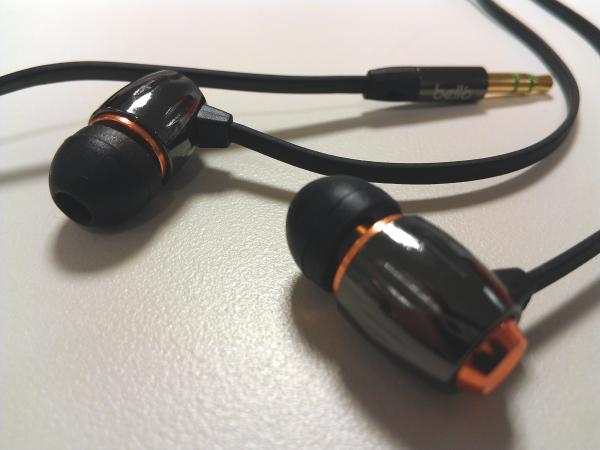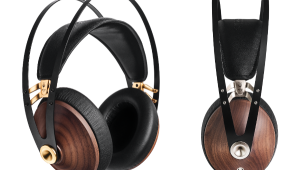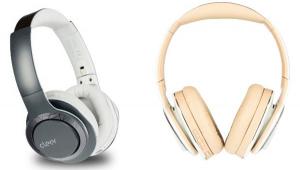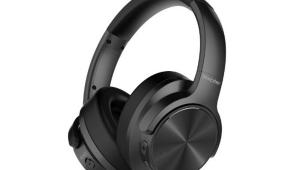Review: Bell'O Digital BDH650 In-Ear Headphones

When Bell'O announced that they were getting into the audio business, I fully expected them to come out with a line of speakers that matched some of their home theater furniture. Makes sense to me that a company with expertise in making TV stands and cabinets could whip up a speaker cabinet, right? Wrong. The first Bell'O foray away from furniture is a line of headphones and surge protectors. I had a chance to listen to the BDH650, a nice-looking set of in-ear headphones.
The BDH650 ($39.99) have an attractive "bullet" design, somewhat reminiscent of the form factor of the popular Klipsch S4. (The headphone is also available as the BDH653, which adds an inline mic, remote, and volume control). The headphones have a very solid feel, but are surprisingly lightweight, and the flat cable that is very resistant to tangles and twists. They have a 24K gold-plated miniplug, but they're not supplied with a ¼" adapter for home theater use. This seems like an oversight from a company known for making home theater equipment. One other possible legacy of the company's home orientation, pointed out by Sound +Vision Web editor Michael Berk, is the straight plug. A headphone that (as you'll read below) doesn't seem to be voiced for critical listening should really have a pocket-friendly right- or 45-degree-angle jack.
The BDH650s come with a small hard-sided case, again with a slight oversight - the headphones come with a variety of eartips, but the case doesn't have a sleeve to hold them. Of course, most people will find one size that works best for them and stick with that, but sometimes I know I like to get a little more or less sound isolation, particularly while traveling.
All these little nitpicks could be overlooked if the BDH650 sounded extraordinary. Alas, they did not. They have a very clean sound, but it was lacking in very deep bass response, no matter which eartip I tried. Worse than that, they have a very shrill high end. I checked them out with Jason Mraz's "I Won't Give Up." The acoustic guitar had a nice, bright sound, but there was a sharp edge to Mraz's voice, even in his lower register. Once he jumped up an octave in the second verse, the sibilance was overwhelming. I was thinking that they might be acceptable with classical music, where a bright sound might be appreciated, but strings had a harsh, strident sound that was just unpleasant to listen to.
Michael didn't find the Bell'Os as bright as I did, though disliked their voicing as well: he found the low end "exaggerated" and "some stridency up high…overall they're a bit boxy sounding; not a smooth-sounding headphone by any means"). Michael felt Don Ross' beautifully recorded acoustic guitar on Passion Session was "stripped of its ambience, sounding like a budget instrument"; likewise he said that the complex mix of Roxy Music's "Mother of Pearl" was "overly submerged in murk." He did feel that stereo imaging was reasonably good, and given the comfortable fit, light weight and on-the-go orientation, thought that at the suggested price point they weren't bad overall.
Bottom Line
Bell'O means "beautiful" in Italian, and the BDH650 certain look beautiful. Sadly, in this case, that beauty is merely skin deep. Bell'O did get the ergonomics and comfort right, and if you like the sound, the BDH650 headphones might be just what you're looking for. Otherwise, you might want to wait for their second foray.
Measurements
I measured the BDH653 using a G.R.A.S. RA0045 ear simulator, a Clio FW audio analyzer, and a Musical Fidelity V-Can headphone amplifier. I used the medium tips, which fit the ear simulator best, then tried reinserting the tips several times and measuring again, settling on a position that yielded the most representative measurement.
The frequency response measurements for the BDH653 are typical for an IEM with a fairly neutral tonal balance. There's a broad rise in the bass peaking at 70 Hz, and a broad treble rise peaking at 6 kHz, but in general this type of measured response produces a subjectively flat response for the listener. Adding 70 ohms output impedance to the V-Can's 5-ohm output impedance to simulate the effects of using a typical low-quality headphone amp does not significantly change the frequency response.
Total harmonic distortion (THD) at 100 dBA is below 1% at frequencies of 70 Hz and higher. Even at 20 Hz, it's only 1.3%.
Impedance is close to dead flat, averaging 24.5 ohms. Isolation is very good: -20 dB at 1 kHz, dropping to -35 to -45 dB at frequencies of 3 kHz and above.
Average sensitivity with a 1 mW signal at measured 25 ohms impedance is 98.3 dB from 300 Hz to 10 kHz, 97.7 dB from 300 Hz to 6 kHz. - Brent Butterworth
- Log in or register to post comments




































































